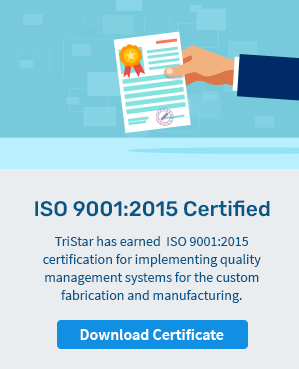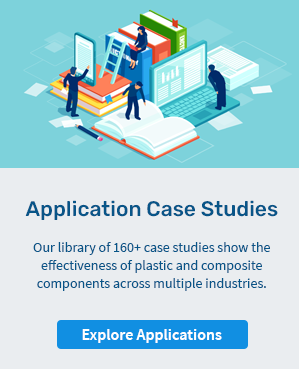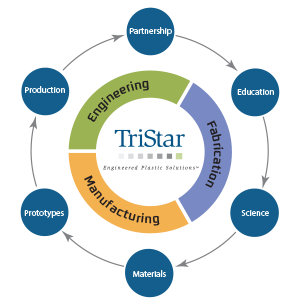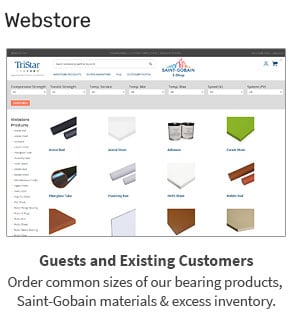
When it comes to high-performance bearing materials, there’s no such thing as a one-size-fits-all solution. From wear and friction to chemical resistance and thermal expansion, advanced polymers behave differently based on a wide range of variables, many of them highly interactive.
The key to achieving optimal performance is not just selecting a capable material, but carefully engineering it to the precise context in which a component will operate. This imperative extends to challenging environmental conditions, system-specific mechanical engineering priorities, and even operational considerations (like the cost and difficulty of repair, replacement, and ongoing maintenance).
At TriStar, we’ve spent decades helping customers navigate these complexities. In many cases, what seems like a straightforward bearing request turns out to hinge on a few critical details. That’s why we approach every project with the same starting point: what is the full picture?
In this blog, we highlight some of the most common sources of complexity in bearing applications, all critical factors that TriStar’s engineering team is here to help evaluate for our customers.
Mating Materials Matter
One of the most overlooked factors in bearing performance is the material it runs against. Different metals and surfaces interact with polymers in specific ways. Some can accelerate wear, introduce galvanic corrosion, or affect heat transfer in ways that reduce lifespan.
TriStar engineers routinely help customers analyze the mating material and select a bearing material that will perform well under those conditions. In some cases, this means switching to a grade with better wear resistance. In others, it may involve recommending an alternative mating surface to improve overall system performance.
Due Diligence for “Drop-In” Replacements
Many customers are rightfully excited about the value that self-lubricating polymer bearings can offer. The potential to eliminate grease, reduce maintenance, and extend service life can offer incredible value. Given these advantages, it can be easy to assume that a given advanced polymer material can be swapped directly into place as a simple replacement for metal.
In reality, even when the geometry is identical, polymers behave differently under load, temperature, and speed. Thermal expansion, deflection, and fit tolerances must all be considered to avoid performance issues.
TriStar’s application review process helps identify these nuances early. By taking the time to understand how the component fits into the full system, we can recommend targeted adjustments (like a tweak to material, a modification to part geometry, or even a special material enhancement process) to ensure the replacement delivers the performance customers expect.
Checking for Potential Chemical Exposure
Polymers vary widely in their resistance to oils, solvents, acids, and cleaning agents. Even small amounts of chemical exposure can cause swelling, embrittlement, or surface degradation if the material is not well matched to the environment.
TriStar’s engineers work with customers to map exposure conditions and identify safe material options. In some cases, the best path forward may include enhancements such as plasma surface treatment to further improve chemical resistance or bonding characteristics.
Planning for High- and Low-Temperature Resilience
High heat can reduce load capacity, accelerate wear, and cause dimensional changes that affect fit or alignment. Cold environments, meanwhile, bring their own challenges, including brittleness and increased friction.
These risks multiply in applications that span both extremes, such as aerospace systems or outdoor equipment subject to rapid temperature swings. A material that performs well at ambient conditions may degrade quickly when exposed to continued thermal cycling.
Rather than defaulting to an off-the-shelf high-temperature polymer, TriStar works with customers to evaluate the full thermal profile of the application, including peak temperatures, sustained loads, and cold-start conditions.
Learn how high temperature bearings helped an aluminum processor reduce repair costs by 3x.
Getting Specific on Speed and Load Requirements
Every polymer has a unique combination of strength, stiffness, and wear resistance. A material that performs well at low speeds and light loads may deform, wear prematurely, or generate excessive heat under more demanding conditions. Load direction and type (oscillating, continuous, or impact-based) can also influence how a bearing will perform over time.
TriStar’s engineering team works with customers to analyze those variables up front. We work to characterize dynamic loads, identify pressure-velocity (PV) limits, and specify materials can handle the full range of projected operating conditions. For especially demanding applications, we commonly recommend filled materials or custom blends to improve strength and/or dimensional stability.
Industry-Specific Constraints
From FDA requirements in food processing to safety standards in aerospace, many applications come with regulatory, certification, or documentation requirements that limit material choices. TriStar’s engineering team is familiar with these constraints and can help customers stay compliant without compromising on performance.
We take a deeper look at industry-specific engineering considerations in our industry guides, available here.
Hands-On Engineering Support That Sees the Whole Picture
Optimal material decision starts with a holistic understanding of the application at hand. That’s why TriStar’s engineering team works closely with customers to pinpoint the demands of a system and develop a solution that will work as planned in the field.
For a deeper look at how engineering support drives better performance from polymer components, download our Guide to Engineering Services for High-Performance Bearings. It’s packed with real-world examples, practical considerations, and insights from our engineering team.








